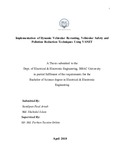| dc.contributor.advisor | Oshim, Mr. Md. Farhan Tasnim | |
| dc.contributor.author | Arnab, Sandipan Paul | |
| dc.contributor.author | Islam, Md. Shahidul | |
| dc.date.accessioned | 2018-05-14T10:36:36Z | |
| dc.date.available | 2018-05-14T10:36:36Z | |
| dc.date.copyright | 2018 | |
| dc.date.issued | 2018-04 | |
| dc.identifier.other | ID 14321027 | |
| dc.identifier.other | ID 14321014 | |
| dc.identifier.uri | http://hdl.handle.net/10361/10145 | |
| dc.description | This thesis is submitted in partial fulfilment of the requirements for the degree of Bachelor of Science in Electrical and Electronic Engineering, 2018. | en_US |
| dc.description | Catalogued from PDF version of thesis. | |
| dc.description | Includes bibliographical references (page 40-41). | |
| dc.description.abstract | Vehicular Ad hoc NETwork (VANET) is based on V2V communications between vehicles and V2I communications between vehicles and V2I communications between vehicles and access points located at the road-side infrastructures. This network would enable accessing real-time traffic conditions, emergencies, routing information and facilitate traffic safety, driver assistance, traffic police assistance and infotainment for passengers. Our research challenge is to ensure communication between incoming vehicles in a certain routes with emergency situations and compare different scenarios in order to give the best alternate route to the user. The choice of routing software along with the mapping and traffic enabling tools were crucial for carrying out the research. This thesis aims at implementation of dynamic re-routing techniques in VANET networks, addresses the challenges and improves by enhancing network capacity and then analyses on challenges and future trends of VANETs. The primary goal is to establish mathematical models to enhance the underlying traffic conditions, driver and vehicle safety applications and the current state of pollution gradient. The secondary goal is to base on the models to devise networking functions and protocols to exploit mobility and radio conditions to optimize VANETs. This re-routing can also be used to investigate and optimize the internetworking between vehicles and vehicles to infrastructure for different types of roads including urban, rural and highways as well as different traffic conditions. | en_US |
| dc.description.statementofresponsibility | Sandipan Paul Arnab | |
| dc.description.statementofresponsibility | Md. Shahidul Islam | |
| dc.format.extent | 41 pages | |
| dc.language.iso | en | en_US |
| dc.publisher | BRAC Univeristy | en_US |
| dc.rights | BRAC University theses are protected by copyright. They may be viewed from this source for any purpose, but reproduction or distribution in any format is prohibited without written permission. | |
| dc.subject | Vehicular rerouting | en_US |
| dc.subject | Pollution | en_US |
| dc.subject | Modern transportation | |
| dc.title | Implementation of dynamic vehicular rerouting, vehicular safety and pollution reduction techniques using VANET | en_US |
| dc.type | Thesis | en_US |
| dc.contributor.department | Department of Electrical and Electronic Engineering, BRAC University | |
| dc.description.degree | B. Electrical and Electronic Engineering | |

